Recently, I was honored to be asked to deliver the keynote speech at the 2024 Annual Membership Meeting of the Education Finance Council. The Education Finance Council is the national trade association representing non-profit and state-based higher education finance organizations. My EFC keynote mostly followed this script:
The Evolution of U.S. Higher Education: The Influence of Technology & Its Ability to Surmount and Create Future Challenges
As Carl Sagan once stated, “You have to know the past to understand the present.” It’s my plan this afternoon to review the 380+ year history of higher education in America. I’ll focus on its last 60 years, particularly the influence of technology during that period.
Additionally, I will discuss recent initiatives that change the way we think about workforce development, education and training, and higher ed.
Many of you may have participated in a college or university academic procession. You know that the representatives of the universities electing to march proceed in order of the date of their founding. Usually, Harvard is first since it was the first institution founded in the colonies.
In their first century or two, colleges were privately funded, usually by a religious order seeking to educate their clergy. Other students attending were usually children of wealthy businessmen or farmers.
Raise your hand if any of you attending today is an alum of one of the 10 oldest colleges in America:
- Harvard (1636)
- College of William and Mary (1693)
- St. John’s College – Annapolis (1696)
- Yale University (1701)
- University of Pennsylvania (1740)
- Moravian College (1742)
- University of Delaware (1743)
- Princeton University (1746)
- Washington & Lee University (1749)
- Columbia University (1754)
The Morrill Act
As our country expanded west, there was a need for engineers to design and build bridges and roads and for agriculture specialists to teach people how to farm more effectively and efficiently. First proposed in 1857, the Morrill Act was signed into law by President Lincoln in 1862 after the Southern states seceded from the Union.
The Act provided states with federal lands (some taken from Native American tribes) that could be sold to raise money or used to establish public colleges. The act opened opportunities for an education to thousands of farmers and people previously excluded from higher education.
There was a second Morrill Act of 1890 that provided money instead of land to establish public colleges in the South. Among schools established under this act were historically black colleges and universities, including Prairie View A&M, Alabama A&M, and Tuskegee.
A Snapshot of Higher Education in 1900
The Morrill Act provided states with the land and funds to establish land grant institutions. At the same time, religious orders continued to found private colleges as America expanded westward after the Civil War.
The number of colleges in the U.S. nearly doubled to 977 from 1860 to 1900. The enrollment of students increased fourfold to 237,592. Nonetheless, few Americans completed high school in those days. Even fewer went to college, and very few college students completed a bachelor’s degree (less than 15% of those who started).
1940: The Eve of World War II
By the eve of World War II, the number of colleges and universities increased to 1,708, a growth rate of more than 75% since the turn of the century. The number of college students enrolling in that period increased more than five-fold to 1.5 million.
Even better than enrollment growth was the improvement in the persistence rate, a measure of how many students finish college. The percentage of college freshmen completing a four-year degree was just under 50% at 49.7%. The percentage of Americans holding a four-year degree or more was still very low – 5.5% for men and 3.8% for women.
1944: The Servicemen’s Readjustment Act
As you can imagine, the number of men enrolled in college during World War II decreased dramatically. During the War, members of Congress discussed ways to avoid an aftermath like World War I, when returning American veterans were jobless and camped out and protested in Washington, DC.
In 1944, Congress passed the Servicemen’s Readjustment Act. The Act provided WWII veterans with funds for job training, college education, unemployment insurance, and housing.
Within seven years, 8 million veterans received education benefits, including 2.3 million for college. The number of bachelor’s degrees awarded in the U.S. doubled between 1940 and 1950. The first version of the Act expired at the end of 1956. At that time, Congress estimated that income tax increases more than repaid the $14 billion expended.
1958: National Defense Education Act
On the heels of the successful GI Bill rollout, Congress passed the National Defense Education Act in 1958. Substantial funds to enable students to attend college were made available through federal funding of low-interest student loans.
By 1960, college enrollments increased to 3.6 million (up 50% from 1950 and without GI Bill students). By 1970, college enrollments increased to 7.5 million (more than doubling in a decade).
It’s important to note that the Senate wanted to provide college grants to students instead of low-interest loans. To get the bill passed, leaders in the Senate acquiesced to the House Chairman’s preference to provide low-interest loans. Who knows what would have happened to our student financial aid system if the Senate’s version had passed instead?
Higher Education Act of 1965
As part of President Johnson’s Great Society programs, the Higher Education Act was passed in 1965. It was the successor to the National Defense Education Act.
Title IV of the Act authorized financial aid to students, including grants, loans, and work-study. Title IV also provided rules for determining financial need.
Nearly six million students were enrolled in college that year with two-thirds of them attending public institutions. Men earning a bachelor’s degree continued to outnumber women graduates nearly two to one.
The Higher Education Act (HEA) was reauthorized every four to five years after its original passage. Thanks to our partisanship in Congress, the last time the HEA was reauthorized was in 2008.
1972: Title IX Amendment to the Higher Education Act
When I arrived at Duke University as a freshman in the fall of 1972, the news on campus (other than the war in Vietnam and the draft) was about Title IX, an amendment to the Higher Education Act that was signed into law by President Nixon in June of that year.
The new law prohibited sex discrimination in any program or activity at an institution receiving federal financial aid. The buzz on campus was the limited time that Duke and all other universities with sports teams had to comply. The law required these institutions to establish women’s sports teams, with the number of female athletes equaling the number of male athletes.
Women classmates of mine who had participated on sports teams in high school were strongly encouraged to try out for newly formed women’s teams as Duke hustled to comply with the provisions of the Act.
Approximately nine million students were enrolled in college in 1972 with almost 80% attending public institutions. This was a three million student increase in the seven years since the passage of the Higher Education Act. Male students continued to outnumber female students, Men earning a bachelor’s degree comprised 15.4% and women with a bachelor’s degree comprised 9.0% of all Americans.
1978: The Year of a Major Tuition Increase
The beginning of rampant college tuition inflation can be traced to Harvard’s decision in 1978 to increase its undergraduate tuition by 18%. For the next decade, it approved annual 8% increases. Other elite institutions followed suit. The escalation of tuition by non-elite private colleges became known as tuition discounting.
As more baby boomers continued to attend college, total enrollments that year exceeded 11 million for the first time. The percentage of American males earning a bachelor’s degree increased to 19.7%, and the percentage of women earning a bachelor’s degree increased to 12.2%.
1989: The University of Phoenix Offers the First Fully Online Degree
A decade later, the University of Phoenix offered the first fully online bachelor’s degree. The degree was established to make it easier for working adult students to attend classes online from home or the office.
Total college student enrollments increased over a ten-year period to 13.5 million students. The percentage of American men with a bachelor’s degree increased to 24.5%. Meanwhile, the percentage of American women with a bachelor’s degree increased to 18.1%. The average student loan balance at graduation for bachelor’s degree recipients was $6,760.
1994: Liberal Arts Colleges: Thriving, Surviving, or Endangered
David Breneman, an economist and former president of Kalamazoo College, described the tuition discounting strategies of small colleges in his book, Liberal Arts Colleges: Thriving, Surviving, or Endangered.
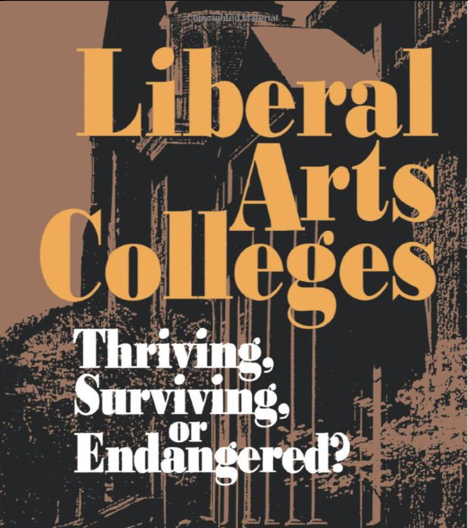
The theoretical reason why small colleges began to artificially inflate their tuition (mirroring Harvard’s increases) was to grant merit scholarships to targeted students. These merit scholarships yielded a higher enrollment of more academically qualified students.
The relationship of tuition to enrollment is portrayed in this simple graph from Breneman’s book.
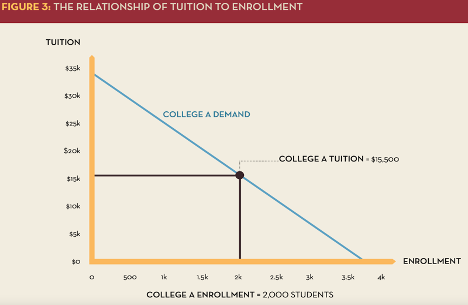
The higher the tuition, the lower the enrollment. The lower the tuition, the higher the enrollment. Colleges could achieve a targeted enrollment at a targeted price if everything worked out as planned. The trick was in the mix of A, B, and C financial aid award groupings that received different merit scholarships or discount rates.
Breneman warned that there was a delicate balancing act required to keep the discount rate at a reasonable level. Little did he or anyone else know at the time how relevant the word “endangered” in his book’s title would become.
1996: The First Online University
The first fiber optic cable was installed in 1996 under the Pacific Ocean, forming the backbone for the worldwide growth of the Internet. Jones International University opened that year as the first fully online university.
The Alfred P. Sloan Foundation established the Sloan Consortium to study online college courses and programs.
Total college enrollments exceeded 14 million. The ratio of male to female college graduates decreased to 1.2:1. The average student loan balance at graduation nearly doubled from 1989 to $12,750.
2005: Remaking the American University: Market Smart & Mission Centered
College insiders are like the canary in the coal mine. The University of Pennsylvania’s Robert Zemsky and Stanford University’s William Massey were tenured professors who warned the higher education sector that the arms race for new students and the influence of U.S. News rankings was changing the culture of college and increasing costs through administrative bloat.
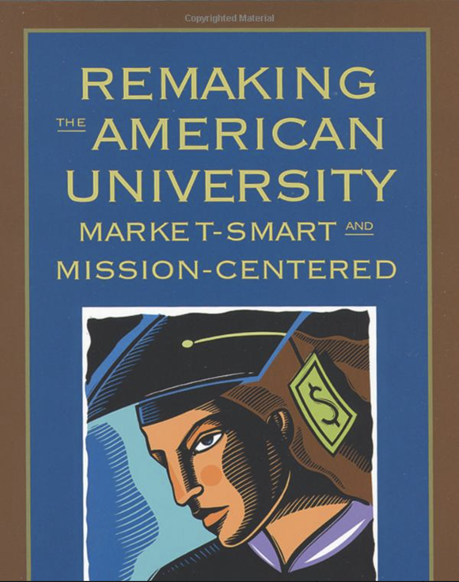
According to the authors (including Gregory Wegner), the quality of education had to be the focus of all colleges, and access had to be expanded. Increasing tuition costs to cover increases in administrators was not helping expand access. All institutions had to be held accountable for their learning outcomes, especially if they admitted less qualified students.
2010: The Early Years of the Obama Administration
Enrollment in higher education reached 21 million in 2010, its all-time high. Gainful employment regulations, the first wave of the Obama administration’s war on for-profit institutions were proposed. The regulations would have been more effective if applied to all colleges and universities given that many high tuition institutions were non-profits.
The bulk of the growth in private institution students from a 1972 base of 2 million to 5.88 million was at for-profit institutions, many of them early adopters of online education. That growth rate by for-profit institutions triggered the ire of many Democrats in Congress and the White House.
President Obama famously called for higher education to reach out to the 30 million Americans with some college and no degree. America needed college graduates, and why not bring back those who had stopped out? The idea had merit, but few from this group responded with a myriad of explanations as to why so few re-enrolled.
The percentage of women earning a four-year degree was nearly equal to the percentage of men at approximately 30%. The average student loan balance nearly doubled from 1996 to $24,200.
2010: The Global Auction: The Broken Promises of Education, Jobs, & Incomes
Remember the fiber optic cables installed under the Pacific and other oceans? By 2010, three UK economists warned that the market value of American workers was part of a global auction for jobs.

A price competition for expertise was stimulated by:
- The supply of college-educated workers in affluent and developing countries doubling over the past 10 years,
- The adoption of new technologies by companies standardizing many technical, managerial, and professional jobs, and
- The quality and cost revolution in emerging economies that produced high-skill, low-wage workers.
An “Opportunity Trap” occurred when everyone worked toward the same opportunity, such as a bachelor’s degree. The only entity or person that secures an advantage in that situation is the employer.
More importantly, the authors identified that the average improvement in lifetime earnings between a high school graduate and a college graduate is distorted. The graduates in the top 10% of the income continuum make $4 million more over a lifetime versus the average of $1.1 million. Remove the top 10th percentile and the average declines substantially.
Brown, Lauder, and Ashton recommended that the U.S. reform its education standards. They proposed increasing graduates in STEM fields. They also encouraged senior managers of U.S. companies to focus on medium-term and long-term returns and not outsource jobs to save money in the short-term.
2011: Disrupting College: Christensen, Horn, Caldera & Soares
Harvard professor Clayton Christensen and his colleagues wrote that traditional universities’ business models were not sustainable. Online degree business models better-optimized learning for students versus traditional college models focusing on research for faculty.
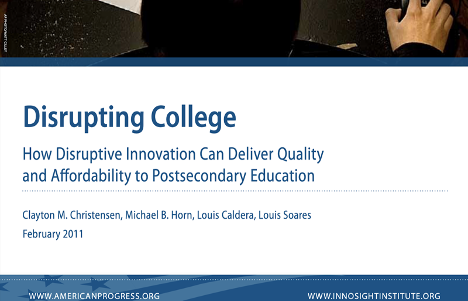
The disruption in the traditional business model caused by the growth in online courses and programs provided a new opportunity. These courses would redefine the meaning of quality in higher education as well as make a quality education fundamentally affordable.
To illustrate the problem of affordability that Christensen and Horn were describing, the chart below shows the contrast between college tuition inflation and other components of the consumer price index in the decade between 2000 and 2010.
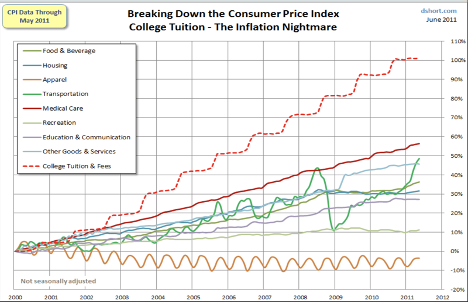
Food and beverage and apparel were relatively flat during this period, while the price of college increased by 100%. Note that 2010 was also the year of higher education’s peak enrollments.
Supporting Christensen’s and Horn’s claims that online education was a more attractive option for students was the growth in online education. By the fall of 2010 more than 6 million students (31% of all college students) enrolled in at least one online class. See other highlights below from Sloan C’s annual report in 2011.
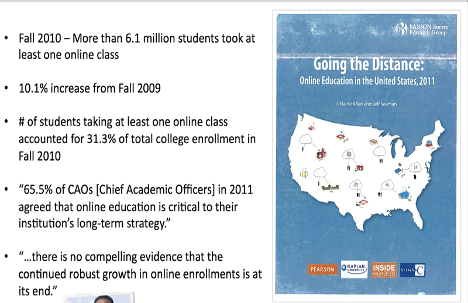
Notably, approximately two-thirds of Chief Academic Officers agreed that online education is critical to their institution’s long-term strategy.
2014: Women College Graduates Take the Lead
The percentage of women in America who earned a bachelor’s degree exceeded the percentage of men for the first time in 2014. Total enrollments decreased by nearly 1 million from 2010. That same year, 72.5% of college students enrolled in public institutions.
Private institution enrollments and public institution enrollments declined nearly equally at approximately 500,000 for each sector. Meanwhile, the average student loan balance at graduation reached $28,650, an 18% increase in four years.
By 2014, tuition discounting had expanded dramatically. In fact, the average total institutional grant aid had grown from $4 million in 1997 to more than $16 million in 2014. Dr. PJ Rine authored a white paper titled A Shell Game by Any Other Name: The Economic Rationale Behind Tuition Discounting that warned the economics were no longer viable.
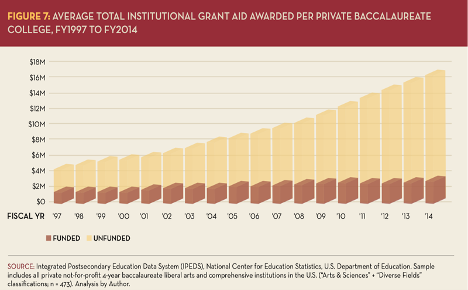
While tuition grew more than 100% from 1997 to 2014, they did not expand four-fold as much as the investment in institutional grants increased. The ratio of the unfunded portion of tuition discounts to the funded portion increased from 2:1 to 5:1 over the same period.
2015: Obama Administration Launches the College Scorecard
The Obama Administration launched the College Scorecard to provide more transparent consumer information about colleges. The scorecard provided enrollment data, earnings, and debt data by degree program (if there were more than 60 grads over a two-year period), the institution’s cost of attendance, and completion rates.
The major weakness then and now is that the Scorecard only reports data for students who borrow. For example, the state of Texas tracks the percentage of its public college graduates who borrow with a goal to keep that number below 40%. That means that the College Scorecard does not report earnings for 60+% of Texas public university graduates.
2015: The Future of the Professions
Richard and Daniel Susskind, father and son professors at Oxford University, wrote The Future of the Professions, the first heavily researched book that provided evidence that white-collar workers would be affected by the adoption of AI-enabled systems.
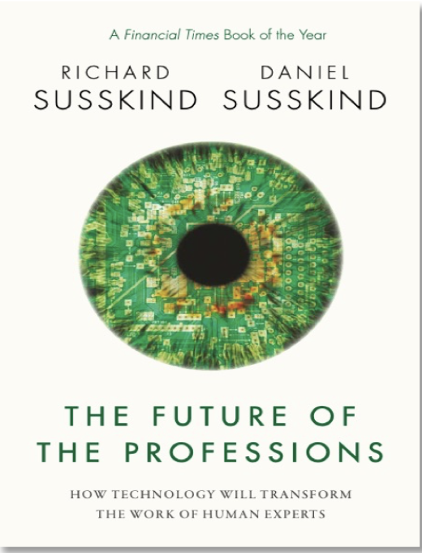
The Susskinds wrote that the market would gravitate toward two forms of a solution:
- An efficiency strategy where firms would find ways to use AI to cut the costs of professional work, and
- A collaboration strategy that would require users of professionals to share the costs.
Thanks to AI replacing those repetitive components of a professional’s job (like reading 90% of x-rays), the Susskinds predict that the professions will be deconstructed. This will create opportunities for other types of workers. Over several decades, there will be technological unemployment in the professions.
2016: Credential Transparency Initiative Becomes Credential Engine
An initiative working with institutional partners to define a common language that people and systems could use to discover and understand different credentials grew into the Credential Engine.
Credential Engine is a registry and consulting company used to track credentials in the U.S. including diplomas, badges, certificates, apprenticeships, certifications, licenses, and degrees of all types and levels. Providers load information in the cloud-based registry, including learning outcomes, cost, and market value.
Credential Engine’s most recent report indicates that $2.133 trillion is spent annually in the U.S. on delivery and attainment of credentials. 59,690 credential providers provide 1.076 million unique credentials in the U.S.
2018: Overview of State Funding of Public Universities
During the early years of the 21st century, private colleges were not the only colleges experiencing pressures on operating margins, costs, and revenues. During the decade from 2008 through 2018, overall funding for state institutions fell $6.6 billion from its pre-2008 recession high.
During that period, 41 states spent less per student, though not necessarily less overall, due to the growth in student enrollments. On average, the states’ spending per student fell 13% or $1,220. Per student funding fell by more than 30% in six states.
The average published tuition rose by 37% during the period, and in eight states, published tuition rose by 60% or more. Public universities increased their recruitment of out-of-state and foreign students to increase their overall revenues per student.
2018: Online Enrollments Grew, but Are Concentrated
This McKinsey graphic below includes only institutions enrolling a minimum of 3,000 students. Notice that the Top 10 universities (not 10%, top 10) enroll 20% of the market. The top 25 universities enroll 30% of the market.
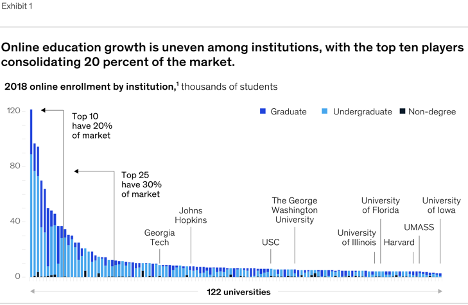
This data in the McKinsey chart below is expressed in FTEs (full-time equivalents). This means that the actual student enrollments are higher, particularly for those institutions serving a high percentage of part-time or working adult students enrolled in online programs. For example, APU’s actual student numbers were approximately double the FTE number expressed in this chart.
2020: The Growth of Online Education
Between 2012 and 2019, the total number of college students decreased by 1.1 million. Over the same period, the number of students taking at least one online class grew to 7.4 million. Approximately 3.5 million students were taking all their classes online in 2020 with 29% of those students enrolled in graduate programs.
Despite the concentration of enrollments at a handful of institutions, 77% of 4,089 institutions offered online degree programs by 2020.
2020: Human Work in the Age of Smart Machines
Jamie Merisotis, CEO of the Lumina Foundation, is likely not a stranger to most of you. His 2020 book, Human Work, called attention to the pending changes in higher education and the workforce based on the continuing adoption of artificial intelligence.
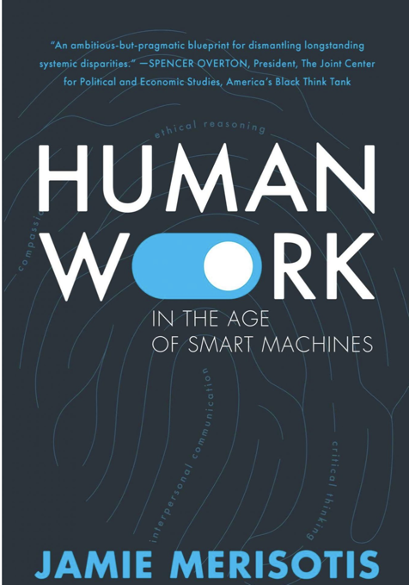
His premise, and the title of the book, is that our future will be about jobs that only humans can do. To future-proof their jobs, more people need higher-level learning, such as complex problem-solving, critical thinking, and creativity. Our colleges and our corporations do not do a good job of developing skills for human work.
For example, employers don’t know what college graduates have learned. Workforce training prepares people quickly for specific tasks, while education prepares people for life beyond work.
Three problems need to be overcome to prepare for the future:
- Most credentials fail to disclose the depth of an individual’s knowledge, skills, and abilities.
- Employers, educators & individuals speak different languages when it comes to skills.
- Pathways through education to most careers are either non-existent or nearly impossible for outsiders to fathom.
Mr. Merisotis’s proposal to make credentials transparent is through the creation of common frameworks. He cited the EU’s European Qualifications Framework as one example. I note also that Lumina was an early funding source for Credential Engine.
Mr. Merisotis wrote that learning pathways should not be based on credit hours earned but based on knowledge and skills gained by people. For this reason, competency-based learning will become the norm instead of the exception. Another Lumina-funded learning-centered framework is the Degree Qualifications Profile (DPQ).
With transparency in learning, individuals can leverage learning to advance careers, do meaningful work, and build better lives. As AI and other tech automate repetitive tasks, human work becomes less about specialized expertise in one task (repeating the predictions made by the Susskinds).
Workers need to own their learning in the same way people need to own their health. Just as we see a trend for people to collect their medical records in a common electronic folder, we will see learning passports maintained by individuals demonstrating their knowledge and their experiences.
2020: Long-Life Learning
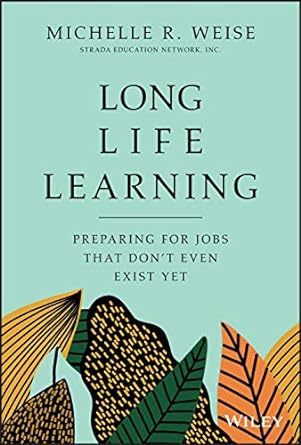
Another book published the same year as Human Work was Long-Life Learning: Preparing for Jobs that don’t even exist yet. Author Michelle Weise worked for Strada Education when she wrote this book.
Ms. Weise’s premise is that increasing life spans will lead to a 60-year work-life. For people to be prepared for an ever-changing work environment, educators and employers must develop a new learning ecosystem. The ecosystem must be navigable, supportive, targeted, integrated, and transparent.
To support the ecosystem, we need a more robust data infrastructure. Ms. Weise provides many case studies about companies that are innovators in workforce development and upskilling. I highly recommend reading this book in addition to Human Work.
2021: Higher Ed Snapshot
By 2021, higher education enrollments declined to 17.3 million from their peak of 21 million in 2010. Approximately 74% of students attended public institutions. Private institution enrollment declined by 1.5 million from its peak. Most of the decline was in the for-profit sector.
Women in the U.S. who earned a four-year degree approximate 39%. This is 2.5% more than the percentage of men with a four-year degree. The average student loan balance at graduation increased to $31,100.
2021: Wall Street Journal Exposes the High Levels of Graduate Degree Debt
During the summer of 2021, the Wall Street Journal published an expose on the high student loan balances incurred by those earning graduate degrees. While the data below shows the median debt for graduates from med schools, law schools, dental schools, pharmacy schools, and rehab programs, the mean (average) debt is much higher.
Median debt for:
- Med school grads (Michigan State) – $228,393
- Law school grads (George Mason) – $121,831
- Dental school grads (Ohio State) – $194,757
- Pharmacy school grads (Oklahoma University) – $139,667
Few graduate programs have a debt-to-earnings ratio less than 1:1. Most are 2:1 or higher.
2021-2024: Biden Administration Department of Education Initiatives
The Biden administration has focused on creating ways to forgive student loan debt and issuing regulations of all kinds during its three-year tenure. It has been silent about encouraging innovation. Commentary and initiatives related to institutional cost-cutting are clearly not a priority for their administration.
Recent Department of Education initiatives appear to be designed to reign back the growth in online education, the probable best hope for lowering the overall cost of a degree. I would rate this administration’s initiatives a D at best.
2022: The College Devaluation Crisis
At the time The College Devaluation Crisis was published, Jason Wingard was the President of Temple University. His writing was more than bold for most college presidents. Not only did higher education enrollments peak in 2010, but according to Mr. Wingard, so did the efficacy of a college degree as a guarantee of value.
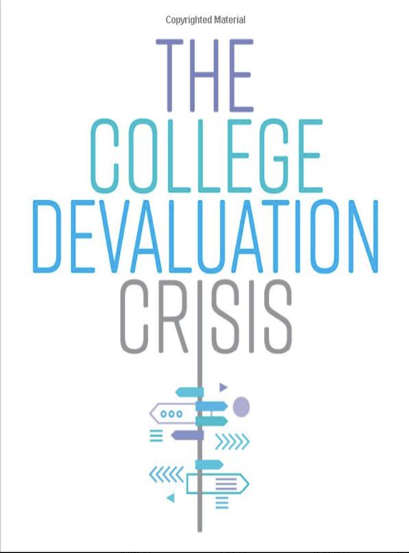
Mr. Wingard predicted that by 2030, a college degree will be replaced as a pathway for career success. The new world of work requires a fresh set of skills and the pathway to building and credentialing those skills will not go through today’s colleges and universities.
My favorite Wingard prediction is that colleges and universities will collectively reduce tuition by 50% by 2030. He’s the only college president who has forecasted that major change. Given the percentage of students receiving tuition discounts, his forecast may be very accurate.
2022: Chat GPT Introduced
On November 30, 2022, Chat GPT was introduced to the public. It was the first of several generative AI large learning models (LLM) to be available for public use. While there are concerns about Open AI’s copyright violations and hallucinations, the fact is that the model will only get better with time as more and more users access it.
Think of the free access as a way to gain hundreds of millions of testers. Chat GPT 4 was introduced in February 2023 for people willing to pay $20 a month for access to its faster speeds. Microsoft licensed the technology for utilization in its Copilot software that integrates with Office 365. By the way, Copilot costs $30/month to embed in Office 365.
2023: Hundreds of AI Tools Available to the Public
By the end of the first quarter of 2023, hundreds of AI tools were available to the public, many of which incorporated Chat GPT’s LLM. The major types of conversions of text input to various outputs are:
- Text to text (e.g., ChatGPT)
- Text to video (e.g., Supercreator.ai)
- Text to images (e.g., Dall-E2)
- Text to research (e.g., Bearly)
- Text to design (e.g., Galileo AI)
- Text to presentations (e.g., SlidesAI)
- Text to audio (e.g., Whisper)
- Text to productivity (e.g., lumen5)
- Text to code (e.g., Github Co-Pilot)
2023: Northeastern University Center for the Future of Higher Education
Politicians and corporate executives have not been shy about announcing that they have begun hiring non-college graduates for jobs that previously required bachelor’s degrees.
The Northeastern University Center for the Future of Higher Education issued a report about the Wellspring Initiative, a survey of 750 corporate HR leaders. The six most notable findings were:
- Most HR systems are not prepared to accept non-degree credentials or richer skills data.
- Candidates’ applications and resumes pass through multiple systems, risking loss of data.
- Most systems do not authenticate education credentials.
- There is a growing interest in supporting skills-based hiring.
- Progress is expected in how systems manage skills data, but the timeframe for implementation is unknown.
- Many talent acquisition systems are utilizing AI.
The HR professionals surveyed also indicated an interest in building a future where individuals own their credentials (confirms Merisotis recommendation).
2023: World Economic Forum 2023 Future of Jobs Report
The World Economic Forum’s 2023 Future of Jobs report predicts by 2027, 70 million new jobs will be created by AI, and 83 million will be eliminated. I think it’s safe to say that employers will likely prioritize job elimination over job creation.
To keep up with these changes, the WEF predicts that nearly half (44%) of worker’s skills need to be upgraded. The top 10 skills that will be in demand include:
- Creative thinking
- Analytical thinking
- Technological literacy
- Curiosity and lifelong learning
- Resilience, flexibility, and agility
- Systems thinking
- AI and Big Data
- Motivation and Self-Awareness
- Talent Management
- Service Orientation and Customer Service
2023: National Apprenticeship Act of 2023
In 2023, Congress passed and President Biden signed the National Apprenticeship Act of 2023, the first major change to the 1937 Apprenticeship Act. The bill codifies standards and regulations, codifies the Department of Labor’s Office of Apprenticeships, and strengthens the connections between DofEd and DOL with a goal of 1 million new programs over the next five years.
The act proposes to increase funding for registered apprenticeships, youth apprenticeships, and pre-apprenticeships. It’s no secret that the Act of 1937 was heavily weighted toward labor unions in its funding priorities. It should be no surprise that the 2023 Act is as well.
2023: Tuition Discounting Continues to Set New Records
An update to the tuition discounting situation shows that the average institutional tuition discount rate has crossed the 50% threshold for all students. It is approaching 60% for first-time, full-time freshmen.
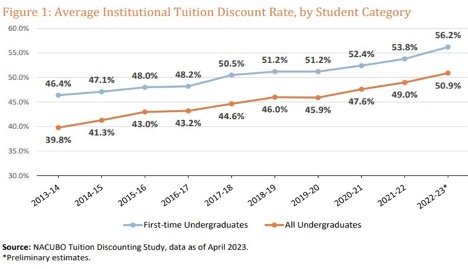
For tuition-dependent colleges and universities, this is an unsustainable rate. Some institutions have initiated tuition resets where they lower the list price of tuition and lower the merit scholarships offered, keeping the existing students whole. Wingard’s premise that tuition will be cut by 50% by 2030 is not too absurd, given this data.
2023: Stanford’s 6th AI Index Report Published Measuring Trends
Stanford’s 6th Annual AI Index Report published Measuring Trends in AI. Notable trends include the substantial lead in industry AI models (32) versus academic AI models (3), the fact that AI models are starting to rapidly accelerate academic progress. Examples are fusion and new antibiotics, the demand for AI-related professional skills is increasing across all industry sectors in the U.S., and the percentage of companies adopting AI in 2022 is double that of 2017.
The percentage of AI adopters has plateaued at 50%. The number of incidents concerning the misuse of AI is rapidly rising. Not surprisingly, policymaker interest in AI has substantially increased. After the 2024 elections, I expect policymaker interest will increase even more, particularly if there are AI-created fake videos.
2023: New America’s Varying Degrees Report
In August 2023, New America, a left-leaning think tank, issued its most recent Varying Degrees report. Among their findings from a nationally normed survey is that 70% of Americans believe those with a college degree earn more than high school graduates.
Only 53% of those surveyed believe that higher education is affordable. Financial aid for low-income students has not kept up with higher education’s increasing costs. The decrease in state funding pushed more costs to families. According to the report, 92% of Americans believe that more transparency is needed about colleges’ return on investment.
Approximately 74% of Americans believe colleges should lose access to federal funds if graduates do not earn a living wage. Something tells me New America positioned its survey questions to arrive at this specific recommendation. I don’t believe the average American understands the federal funding relationship to colleges.
2023: Workforce Almanac Created
Researchers at Harvard’s Next Level Lab announced the creation of the Workforce Almanac in 2023. The postsecondary workforce development training sector is largely concentrated in silos where apprenticeship programs differ from associate degrees which differ from boot camps, etc. Funding mechanisms are stratified, and data transparency across silos is limited.
To meet learners’ needs and to find mechanisms to cross-fertilize initiatives, Harvard created the Almanac. There are nearly 17,000 workforce development training providers in the U.S., spread evenly across the four regions (East, South, Midwest, and West).
The evenly spread regions change when you examine the data on a state-by-state basis, with 32.4 training providers per 100,000 people in Maine and only 6 per 100,000 people in Nebraska.
The spread is worse on a county level, with only 12% of counties having at least one of the four types of providers included in the data set of community colleges, WIOA-eligible programs, registered apprenticeship programs, and non-profit programs.
Workforce development training providers are slightly more likely to be in counties with a higher percentage of college graduates than in counties with a higher percentage of high school graduates or less.
When you look at the composition of training providers by the four categories established by the Almanac, 40% of providers are job training nonprofits, 33% are higher education institutions, 13% are for-profit providers, and 13% are apprenticeship providers.
2023: President Biden Announces 31 Tech Hubs
Buried in the CHIPS and Science Act of 2022 was the creation of regional tech hubs around the U.S. to strengthen our economic and national security. There were 400 applicants from every state and several U.S. territories that met the initial deadline. In October, President Biden announced the first 31 inaugural tech hubs.
These hubs are organized into the following designated areas:
- Safe and Effective Autonomous Systems
- Maintaining Our Quantum Edge
- Advancing Biotechnology: Drugs and Devices
- Advancing Biotechnology: Precision and Prediction
- Accelerating our Energy Transition
- Strengthening our Critical Minerals Supply Chain
- Regaining Leadership in Semiconductor Manufacturing
- Growing the Future of Materials Manufacturing
The initial 31 recipients are eligible for an aggregate of $500 million authorized by Congress. Expect future jobs initiatives to surface through partnerships from many of these hubs.
2023: SkillsFWD Awards Six Inaugural Grants
In late 2023, SkillsFWD funded inaugural grants for six projects solving challenges around the adoption and accessibility of learning and employment records (LERs). The awardees were:
- Accelerate Montana: Pilots LERs in the construction trades and technology industries
- Alabama Talent Triad: Scales statewide pathways from entry level to middle skills jobs across four industries
- Central Ohio Talent Network: Uses SchooLinks work-based learning solution to match early career talent and employers
- ColoradoFWD: Uses LERs to match skills & talent to address urgent direct care and behavioral healthcare talent shortages
- Arizona State University: Students seeking work empowered through LER
- Connecticut Workforce Strategy: Expands state skill-based hiring ecosystem through LERs
The Rockefeller Foundation initially funded SkillsFWD. It receives additional funding support from Ascendium Education Group, the Charles Koch Foundation, Strada Education Foundation, Walmart and others.
December 2023: SNHU President’s AI Initiative
Paul LeBlanc announced in December of 2023 that he was stepping down as president of Southern New Hampshire University to focus on AI. He issued the following statement:
“I am in the camp that says AI changes everything, like fundamentally changes society, the nature of the workforce, the information economy, all of it. If that is true, then universities have to change dramatically as well.”
I totally agree with President LeBlanc’s statement. AI will change everything. The pace is not predictable because government regulations could get in the way. LeBlanc confirms the importance of colleges to determine which fields of study are important in an AI-enabled world.
He confirms what the Susskinds, Jamie Merisotis, and Michelle Weise, among others, have said. Professionals will be judged less by what they know than what they can do with what they know.
To provide you with the importance of the AI project, it is rumored that SNHU’s board approved investing $1 billion in the initiative. I doubt we’ll see Harvard or any of the other elite colleges and universities act. In spite of vast resources, they’re unlikely to commit money to a project to transform education because of AI’s impact.
2024: Google Certificates
Alternative certifications are among the areas predicted for high growth as workers look to reskill and upskill. Google was among the first of several large companies to create affordable certificates that, upon completion, qualify the individual for a job. The certs typically require 10 hours a week for six months to complete.
Google’s certificates are self-paced. If you have more free time, you can complete them quicker. Google’s certificates are among 51 certifications offered by AWS, PwC, CVS, IBM, Salesforce, and others through the Coursera platform. Of the 250k+ people who have completed Google’s certs, 75% have indicated that they upgraded their jobs or switched employers for a better job.
2024 Deep Learning: Five New Superpowers of Higher Education
Jesse Klitgaard Stricker published in his Future of Higher Education column the Five New Superpowers of Higher Education due to Deep Learning.
The five superpowers are:
- Hyper-personalized instruction
- Adaptivity in the learning process
- Expand access to high-quality education by allowing complex subject matter to be encoded into software
- Provide immediate formative feedback
- Redefine assessment through a continuous stream of interactions
Unlocking the power of these five superpowers will require substantial work even though the technology is presently capable.
2024: AI Uses in K-12 Education
Personalized learning through AI algorithms is already available in various software. These tools analyze students’ individual strengths, weaknesses, and learning styles to tailor educational content, pacing, and assessments. This approach accommodates diverse learning needs and maximizes student engagement and understanding.
AI-driven grading tools are now able to grade essay questions and papers, providing valuable feedback to students with grading rubrics selected by the instructor.
Virtual tutors and chatbots offer 24/7 support, responding to questions and reinforcing learning concepts outside traditional classroom hours.
Virtual reality and augmented reality classroom experiences enrich the educational process, allowing class field trips to faraway museums or archeological digs with live teams in other countries.
Early adopters of Generative AI models like ChatGPT are still in the exploratory stage with innovative classroom engagements, teaching students how to utilize the technology and leverage learning instead of utilizing it to plagiarize assignments.
Some concerns about the adoption of AI in K-12 education relate to the possibility that the AI design is biased because of the data set used or the unintentional bias of algorithms by its designers. Loss of the human touch in education, particularly the social aspects of learning, may impact the holistic development of the learner.
Collections of vast amounts of student data by AI concern privacy advocates. Lastly, relying on AI for assessment and analytics may result in learner dependency that could limit their critical thinking and creativity.
2024: Apple Announces Availability of Vision Pro
Early in 2024, Apple announced the availability of Vision Pro, its product that enhances other VR/AR products. Termed “spatial computing” by Apple, the product blends digital content with the physical world. Experiences are controlled by the user’s eyes, hands, and voice.
A new app store has been designed for Vision Pro, and 1 million+ apps have been certified for the product. In addition, new productivity apps for Vision Pro have been released.
As much as I am a techno-geek, I did not buy a Vision Pro. It’s my belief that this product will see extensive use by developers, and, over time, the software will be incorporated into other products like eyeglasses and mobile phones.
2024: Accenture Announces Acquisition of Udacity
Last month, Accenture announced its intended acquisition of Udacity. Reasons cited for the acquisition include Udacity’s capabilities of integrating proprietary content, expert services, and scalable learning. Udacity has served 21.5 million learners in 95 countries since 2011.
Accenture cited the need for enterprises to train and upskill people in cloud, data, and AI as they rebuild their digital core as a reason they believe this acquisition is merited. Given Accenture’s global footprint and large corporate customers, this acquisition is likely to be a win-win for both companies.
Challenges for the Education/Workforce Development Continuum
It’s clear that traditional higher education is in trouble. Student loan debt is at $1.7 trillion, and there are no solutions in sight to reduce student borrowing. President Biden proposed to forgive debt but didn’t propose how to solve the high cost of a traditional college education.
Free community college initiatives are popular but generally only cover tuition, not the other costs of attendance. Tuition discounting for small colleges is at an all-time high and likely past the point of no return for some.
Most traditional four-year degrees do not provide the skills required by employers. Practically oriented STEM degrees limit access to increased enrollments of students at many institutions.
We need to rebuild our high school vocational education programs and change the “everyone needs to go to college” mindset. Community colleges need to seek more employer partnerships and emphasize their capabilities and affordability at local high schools.
K-12 education outcomes are a disaster. Colleges can’t be expected to catch up with students who have deficiencies in math and reading.
Colleges now compete with free content. OERs and MOOCs are some of the fastest-growing sources of alternative education.
The Federal deficit is at an all-time high. Don’t expect the boost in funding from the federal Covid monies to return after expiring this year.
The Northeast and Midwest are experiencing population declines, the “demographic cliff.” Institutions dependent on enrollment and tuition, particularly in the Northeast and Midwest, are in trouble.
ChatGPT and other generative AI tools will force the higher education curriculum to change.
Employers will expect college graduates to be familiar with AI tools. “You don’t have to learn how to use ChatGPT, but your successor will know how to use it” is a statement I recently heard a public company CEO make. He is probably not the only CEO with that belief.
Credential Engine’s database and data reporting framework for all credentials is a major initiative and accomplishment, but one without government approval or endorsement.
We have not yet solved the transfer credit recognition problem. This issue is more exacerbated with micro-credentials that learners would like to stack into a certificate that could stack into a diploma or degree.
The Biden administration has not embraced online education, technology, or innovative and lower-cost options, even though most Americans believe higher education is no longer affordable.
Who Survives?
- Elite universities have the brand, demand, endowment, quality reputation, and access to families that can afford to pay full tuition.
- Public flagships will survive if for no other reason that the majority of a state’s legislature usually attended the state’s flagship university or its land grant university.
- Four-and two-year public colleges that states choose to survive. This will be a complicated and often political process, but consolidation is likely to occur in most states. How many research universities does the average state need?
- Large online institutions will survive. Southern New Hampshire and Western Governors are the two largest universities in the U.S. in terms of enrolled students.
- Community colleges with online excellence and local employer partnerships will survive.
- Alternative education providers with employer partnerships may see the highest growth in enrollment among all these surviving groups. While there are some
- large alternative education providers like Coursera and Udacity, I am not prepared to declare which ones might ultimately be the big winner(s).
Who Thrives?
- Large online universities, if they aren’t regulated out of existence.
- Alternative education providers like Google, AWS, IBM, Coursera, Accenture, etc. that are either large employers or aligned with them. The key determinant for
- alternative education providers is their ability to acquire customers at a reasonable cost and keep them. Elite institutions and public flagships in wealthy states.
AI-related Ed Tech Companies to Watch
There are hundreds of companies that have built or are building products to:
-
-
- Improve retention,
- Change student learning outcomes,
- Enhance student engagement,
- Lower costs of advising,
- Decrease time and cost to build online courses, and
- Offer in-demand certificates for first-level professionals, etc.
-
A few that I have met with over the past year are listed below:
-
-
- Acadeum
- Catalyte
- Gobekli
- NearPeer
- Nolej
- Pathstream
- Sagax
- YellowDig
-
I am glad to discuss these companies and others you may know of.
Questions?
As always, I am glad to answer any questions you may have.
Postscript
In adapting my speech for a blog post, I added about 1,000 words. Somehow, I’m able to deliver bullet points while speaking better than I can include them in a written document. Nonetheless, the speech was delivered in an hour with a few minutes for questions and answers.











